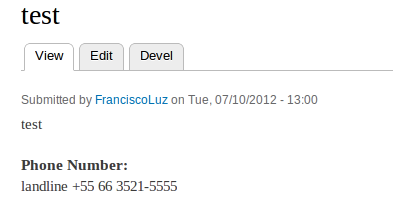 Support for Drupal 7 is ending on 5 January 2025—it’s time to migrate to Drupal 10! Learn about the many benefits of Drupal 10 and find migration tools in our resource center.
Support for Drupal 7 is ending on 5 January 2025—it’s time to migrate to Drupal 10! Learn about the many benefits of Drupal 10 and find migration tools in our resource center.This project is not covered by Drupal’s security advisory policy.
Composed Field is an implementation of core's Field UI that allows you to split a single field into as many sub-fields as you like.
You can configure each sub-field types and attributes as they were literally a single field.
All the Form Controls are configurable through the Field Widget Form.
Features
- Each sub-field element type can be individually set to:
checkbox, checkboxes, date, fieldset, file, machine_name, managed_file, password, password_confirm, radio, radios, select, tableselect, text_format, textarea, textfield, vertical_tabs, weight.
- The following field display settings are available:
Unformatted list (default), Fieldset, HTML list, Table, Accordion, Tabs, Dialog
How does it work?
Each field stores its value as a serialized array into the database. Each array element represents the sub-field value.
For instance:
Say you have a field for collecting phone numbers, the phone number field element will have these sub-fields:
Landline/Mobile (select options) | Country Code (select options) | Area Code (select options) | Number (textfield)
The sub-field values will be lumped together into an array like this:
array(
[1] => 'landline', // Landline / Mobile sub-field.
[2] => '55', // Country code sub-field.
[3] => '66', // Area code sub-field.
[4] => '3521-5555', // Number sub-field.
);
After that the array is serialized and stored into the database as a single value.
Similar Modules
- Double Field is limited to 2 sub-fields only and each sub-field only supports textfield, select list, single checkbox and textarea types.
Composed Fields supports an unlimited number of sub-fields and each sub-field can be set with any of the element types listed in Form Controls - The Field collection uses a different approach for creating composed fields. Here are the main differences between this module and the "Field Collection":
The host field created by "Field Collection" is in fact an entity that gets attached to the fieldable entities (nodes, taxonomy, comment, commerce products, etc). So, although you attach a Field Collection through the Field UI, what is being attached is not a field but an entity.
Once you get your new entity (host field) attached to your fieldable entity (node, comment, taxonomy, commerce product, etc) then you have to attach the fields ( what would be the subfields ) into the host field ( Field Collection entity).
Each subfield is actually a field on its own, that is, from the database point of view, each subfield is a single field.
"Composed Field" on the other hand attaches a field (host field), not an entity, to your fieldable entities (node, comment, taxonomy, commerce product, etc) through the Field UI. At the end of the day, even if you set a field with say 4 subfields, you will end up having only one field and a single value saved into the database.
Unless you have a very specific use case need "Composed Field" should do what you need with less effort and less resources.
How to use
Once you enable this module you will have a new "Type of data to store" called Composed Field at the Field UI.
You should also give permission to trusted roles for entering PHP code into the sub-field attributes that requires it so for functioning, like for instance the #ajax callback function name.
Project information
386 sites report using this module
- Created by FranciscoLuz on , updated
This project is not covered by the security advisory policy.
Use at your own risk! It may have publicly disclosed vulnerabilities.
Releases
Development version: 7.x-1.x-dev updated 17 Jul 2012 at 00:11 UTC














